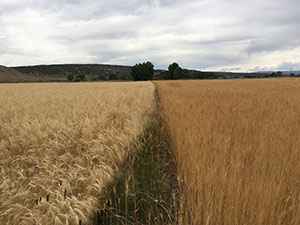UW Extension Reports Ancient Grains May Offer New Opportunities for Wyoming Producers
Published March 17, 2023

Wyoming may be well positioned to capitalize on the growing demand for products made with ancient grains, a new study by University of Wyoming Extension suggests.
The publication, titled “Growing Einkorn, Emmer and Spelt in Wyoming,” analyzes the results of four years of trials conducted on Wyoming farms and agricultural experiment stations. These experiments tested the viability of producing three types of ancient wheat suitable for Wyoming growing conditions.
“These ancient grains provide an alternative to malt barley and wheat grown in the Big Horn Basin and in southeast Wyoming,” says Caitlin Youngquist, UW Extension educator and co-author of the publication. “It gives farmers another choice for cash crops.”
Wyoming farmers already grow 250,000 acres of wheat, oats and barley annually. Ancient wheats, such as einkorn, emmer and spelt, can be incorporated into current crop rotations and grown with existing equipment.
While ancient grains have been plunged back into the spotlight recently, these crops also are part of Wyoming’s history. In the early 1900s, Worland was home to an emmer breakfast cereal factory, the authors note.
Ancient grains typically have higher protein content than most modern wheat varieties and can be used for baking, cooking and even brewing beer.
Einkorn, emmer and spelt are taller than modern varieties, with more robust roots and greater leaf area. Farmers in the Big Horn Basin found that emmer and spelt require less water than malt barley, likely due to these larger root systems.
The height of these plants also means that they produce very high-quality straw, a secondary marketable product, Youngquist says. Results suggested that emmer and spelt are viable as forage and fodder crops in Wyoming.
Like anything, the authors acknowledge, ancient grains have drawbacks. For instance, most ancient wheat varieties are not free threshing, which means they require additional post-harvest processing. In the research trials, a dehuller at the Powell Research and Extension Center was used to complete this step.
However, despite potential challenges, the authors conclude that ancient grains offer promising options to diversify crops and revenue in Wyoming.
To download a free copy of the publication, go here.
About University of Wyoming Extension
Since 1914, UW Extension has provided lifelong learning opportunities to Wyoming citizens across the state. With roots in agricultural education, UW Extension supports rural communities facing contemporary challenges and changes. UW Extension brings the university’s resources to each of the state’s 23 counties and the Wind River Indian Reservation. To learn more about UW Extension, visit www.uwyo.edu/uwe or call (307) 766-5124.

